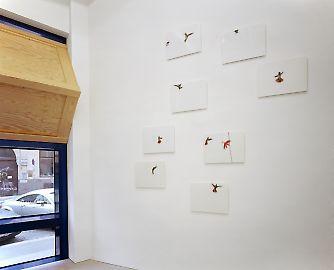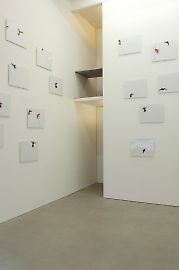Sanna Kannisto -- act of flying
Photographic orbits
We are accustomed to expect of the photographic medium the capacity to arrest, then to record, and finally to collect. Photography halts motion, captures it on a registering device, and saves it in the archives of the preserved image.(…) .
Kannisto’s images (…) using the language of science, in the world of knowledge, where collecting, observation and marking are usually followed by mastery and analysis. (…)
The series Hummingbird flight, Eupetomena macroura 1-12, (2005) acts at the limits of photography in two significant ways: the Hummingbird challenges the framing as well as the speed of the production of the image. Kannisto tests photography’s ability to faithfully reproduce the tones of the tiny wings, even if the wing strokes and flight patterns are mapped against the invisible coordinates of a white space, which in turn offers the bird full attention. Studies of motion hold an important place in the history of photography as images that reveal things which ordinary sight could not perceive. The starting point for their analysis is often the stopping of time, a negation of movement. Motion studies are sculptural – they tell us more about charged force and potential movement than about movement itself as a flowing and experienced event.
The photography of Sanna Kannisto offers not only a compellingly stopped moment, but also an intense sharpness, which brings nature’s details, albeit in unnatural poses, within our reach. (…) Regarding her images we can also speak of two different kinds of arrest – stopped motion and staged pause, i.e. still life – a kind of ‘tableau vivant’ realised in photography.
In Kannisto’s images we see many different views from scientific research laboratories. Often they appear as empty stages, devoid of people, but there are always instruments and markings left behind, which reveal that experiments are continuously in progress. We are given the feeling of having intruded a place one does not belong to. (…) Without the goal directed activities of scientists and without a reassuring narration explaining the aims of the experiments or the significance of the various life-forms within the ecological system, we are at once drawn into the forest’s strangeness.
from: HARRI LAAKSO, catalogue of the Helsinki Photography Festival 2005





